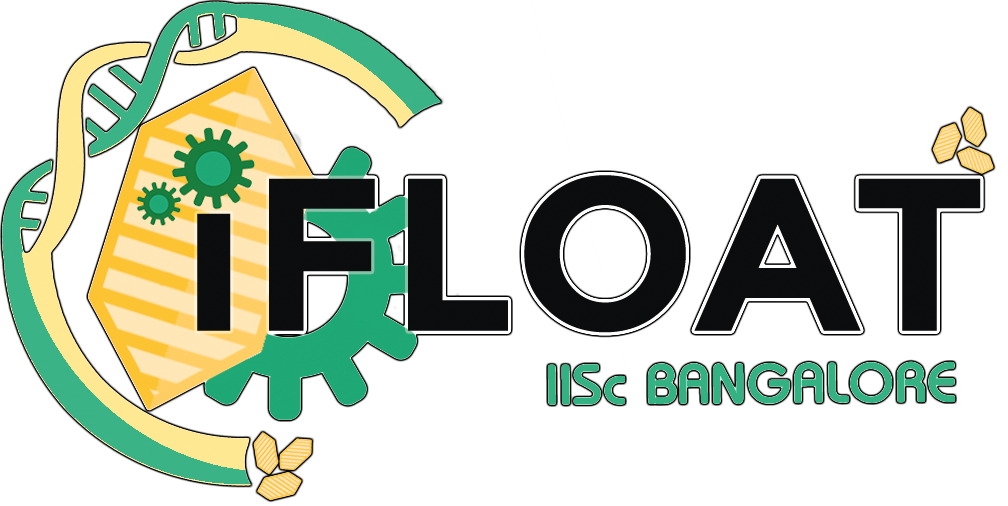Shreygupta (Talk | contribs) |
Shreygupta (Talk | contribs) |
||
| (29 intermediate revisions by the same user not shown) | |||
| Line 3: | Line 3: | ||
<link rel="stylesheet" type="text/css" href="https://2017.igem.org/Template:IISc-Bangalore/CSS?action=raw&ctype=text/css" /> | <link rel="stylesheet" type="text/css" href="https://2017.igem.org/Template:IISc-Bangalore/CSS?action=raw&ctype=text/css" /> | ||
| − | + | <style> | |
| + | .textclass:hover { | ||
| + | text-decoration: none !important; | ||
| + | } | ||
| + | </style> | ||
<div id="fullpage"> | <div id="fullpage"> | ||
| − | <div class="section"> | + | |
| + | |||
| + | <div class="section" style="background-image: url('https://static.igem.org/mediawiki/2017/8/84/T--IISc-Bangalore--gif-bg.png'); background-size: cover; background-repeat:no-repeat;"> | ||
<div class="gifAnimated" style="background-image: url('https://static.igem.org/mediawiki/2017/4/43/T--IISc-Bangalore--iFLOAT-final.gif');"></div> | <div class="gifAnimated" style="background-image: url('https://static.igem.org/mediawiki/2017/4/43/T--IISc-Bangalore--iFLOAT-final.gif');"></div> | ||
</div> | </div> | ||
| + | |||
| + | |||
<div class="section"> | <div class="section"> | ||
| − | <div class="gifAnimated" style="background-image: url('https://static.igem.org/mediawiki/2017/2/21/T--IISc-Bangalore--home-1.gif');"></div> | + | |
| + | <div class="gifAnimated" style="background-image: url('https://static.igem.org/mediawiki/2017/2/21/T--IISc-Bangalore--home-1.gif'); background-position: left;"></div> | ||
| + | |||
| + | <div style="position: absolute; right: 5%; width: 35%; font-size: 2.3em; line-height: 1.4; font-family: 'Poppins'; top: 50%; transform: translateY(-50%);">Gas vesicles (GVs) are hollow protein nanostructures synthesized by phototrophic haloarchaea and cyanobacteria to regulate their flotation in aquatic habitats. </div> | ||
| + | |||
</div> | </div> | ||
| + | |||
| + | |||
<div class="section"> | <div class="section"> | ||
| − | <div class="gifAnimated" style="background-image: url('https://static.igem.org/mediawiki/2017/6/63/T--IISc-Bangalore--home-2.gif');"></div> | + | |
| + | <div class="gifAnimated" style="background-image: url('https://static.igem.org/mediawiki/2017/6/63/T--IISc-Bangalore--home-2.gif'); background-position: right;"></div> | ||
| + | <div style="position: absolute; left: 3%; width: 33%; font-size: 2.3em; line-height: 1.4; font-family: 'Poppins', sans-serif; top: 55%; transform: translateY(-50%);">Bioengineered GVs have been genetically modified for diverse purposes; ultrasonic molecular imaging, gauging cellular turgor pressures, and vaccine delivery - but none of their current applications exploit their most fundamental characteristic: buoyancy.</div> | ||
</div> | </div> | ||
| + | |||
| + | |||
<div class="section"> | <div class="section"> | ||
| − | <div class="gifAnimated" style="background-image: url('https://static.igem.org/mediawiki/2017/4/45/T--IISc-Bangalore--home-3.gif');"></div> | + | <div class="gifAnimated" style="background-image: url('https://static.igem.org/mediawiki/2017/4/45/T--IISc-Bangalore--home-3.gif'); background-position: left;"></div> |
| + | <div style="position: absolute; right: 5%; width: 20%; font-size: 2.3em; line-height: 1.4; font-family: 'Poppins'; top: 55%; transform: translateY(-50%);">Our modelling shows that clusters of GVs float enormously better than individual GVs.</div> | ||
</div> | </div> | ||
| + | |||
| + | |||
<div class="section"> | <div class="section"> | ||
| − | <div class="gifAnimated" style="background-image: url('https://static.igem.org/mediawiki/2017/7/71/T--IISc-Bangalore--home-4.gif');"></div> | + | <div class="gifAnimated" style="background-image: url('https://static.igem.org/mediawiki/2017/7/71/T--IISc-Bangalore--home-4.gif'); background-position: right;"></div> |
| + | <div style="position: absolute; left: 3%; width: 30%; font-size: 2.3em; line-height: 1.4; font-family: 'Poppins', sans-serif; top: 55%; transform: translateY(-50%);">iFLOAT aims to improve the flotation of gas vesicles by clustering them using three distinct methods: charge-based flocculation, biotin-streptavidin interaction, and SpyCatcher-SpyTag heterodimerization</div> | ||
</div> | </div> | ||
| + | |||
| + | |||
<div class="section"> | <div class="section"> | ||
| − | <div class="gifAnimated" style="background-image: url('https://static.igem.org/mediawiki/2017/6/6a/T--IISc-Bangalore--home-5.gif');"></div> | + | <div class="gifAnimated" style="background-image: url('https://static.igem.org/mediawiki/2017/6/6a/T--IISc-Bangalore--home-5.gif'); background-position: left;"></div> |
| + | <div style="position: absolute; right: 5%; width: 25%; font-size: 2.3em; line-height: 1.4; font-family: 'Poppins'; top: 55%; transform: translateY(-50%);"> Future applications of these clusters can include bioremediation of oil spills, flotation-based separation, and purification of specific targets from mixtures!</div> | ||
</div> | </div> | ||
| + | |||
| + | |||
<div class="section"> | <div class="section"> | ||
| − | + | <div style="width: 15%; margin: 0 2.4%; float: left;"> | |
| + | <a href="https://2017.igem.org/Team:IISc-Bangalore/Team"><img src='https://static.igem.org/mediawiki/2017/8/8e/T--IISc-Bangalore--icons-about.svg' width=100% /> | ||
| + | <div style="font-size: 2.5em; font-family: 'Raleway-ExtraBold', sans-serif; margin-top: 20px; text-align: center; color: black;" class='textclass'>ABOUT</div></a> | ||
| + | </div> | ||
| + | <div style="width: 15%; margin: 0 2.4%; float: left;"> | ||
| + | <a href="https://2017.igem.org/Team:IISc-Bangalore/Description"><img src='https://static.igem.org/mediawiki/2017/3/3b/T--IISc-Bangalore--icons-project.svg' width=100% /> | ||
| + | <div style="font-size: 2.5em; font-family: 'Raleway-ExtraBold', sans-serif; margin-top: 20px; text-align: center; color: black;" class='textclass'>PROJECT</div></a> | ||
| + | </div> | ||
| + | <div style="width: 15%; margin: 0 2.4%; float: left;"> | ||
| + | <a href="https://2017.igem.org/Team:IISc-Bangalore/Assembly"><img src='https://static.igem.org/mediawiki/2017/6/6f/T--IISc-Bangalore--icons-lab.svg' width=100% /> | ||
| + | <div style="font-size: 2.5em; font-family: 'Raleway-ExtraBold', sans-serif; margin-top: 20px; text-align: center; color: black;" class='textclass'>LAB</div></a> | ||
| + | </div> | ||
| + | <div style="width: 15%; margin: 0 2.4%; float: left;"> | ||
| + | <a href="https://2017.igem.org/Team:IISc-Bangalore/Hardware"><img src='https://static.igem.org/mediawiki/2017/f/f7/T--IISc-Bangalore--icons-hardware.svg' width=100% /> | ||
| + | <div style="font-size: 2.5em; font-family: 'Raleway-ExtraBold', sans-serif; margin-top: 20px; text-align: center; color: black;" class='textclass'>HARDWARE</div></a> | ||
| + | </div> | ||
| + | <div style="width: 15%; margin: 0 2.4%; float: left;"> | ||
| + | <a href="https://2017.igem.org/Team:IISc-Bangalore/HP/Silver"><img src='https://static.igem.org/mediawiki/2017/8/8f/T--IISc-Bangalore--icons-community.svg' width=100% /> | ||
| + | <div style="font-size: 2.5em; font-family: 'Raleway-ExtraBold', sans-serif; margin-top: 20px; text-align: center; color: black;" class='textclass'>COMMUNITY</div></a> | ||
| + | </div> | ||
</div> | </div> | ||
</div> | </div> | ||
| Line 36: | Line 82: | ||
navigationPosition: 'right', | navigationPosition: 'right', | ||
navigationTooltips: ['first', 'second', 'third', 'fourth', 'fifth', 'sixth'], | navigationTooltips: ['first', 'second', 'third', 'fourth', 'fifth', 'sixth'], | ||
| − | showActiveTooltip: | + | showActiveTooltip: false, |
slidesNavigation: false, | slidesNavigation: false, | ||
slidesNavPosition: 'bottom', | slidesNavPosition: 'bottom', | ||
Latest revision as of 03:41, 2 November 2017
Gas vesicles (GVs) are hollow protein nanostructures synthesized by phototrophic haloarchaea and cyanobacteria to regulate their flotation in aquatic habitats.
Bioengineered GVs have been genetically modified for diverse purposes; ultrasonic molecular imaging, gauging cellular turgor pressures, and vaccine delivery - but none of their current applications exploit their most fundamental characteristic: buoyancy.
Our modelling shows that clusters of GVs float enormously better than individual GVs.
iFLOAT aims to improve the flotation of gas vesicles by clustering them using three distinct methods: charge-based flocculation, biotin-streptavidin interaction, and SpyCatcher-SpyTag heterodimerization
Future applications of these clusters can include bioremediation of oil spills, flotation-based separation, and purification of specific targets from mixtures!











